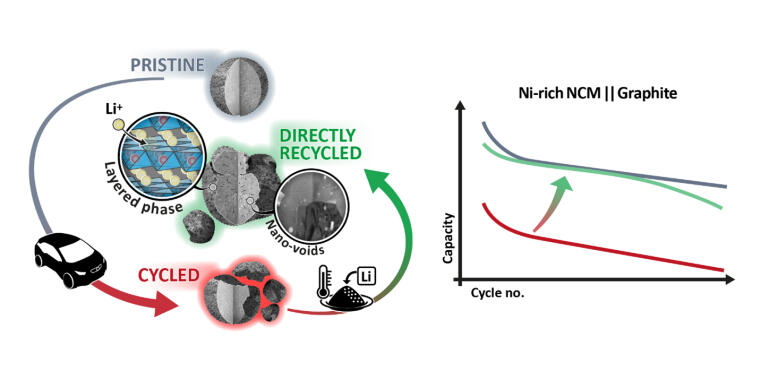Direct Recycling Successfully Applied to Nickel-rich Layered Oxide Cathodes
Nickel-rich layered oxides such as lithium nickel cobalt manganese oxide (NCM) are considered a suitable cathode material for high-energy lithium-ion batteries. The direct recycling of this material is an important step towards further increasing the sustainability of these cell systems. In contrast to conventional recycling, in direct recycling the material is not first broken down into its individual parts and synthesized from scratch, but the processed, aged materials are rejuvenated and reused directly in cell construction. In a recent study, scientists from MEET Battery Research Center, the Institute of Inorganic and Analytical Chemistry and the Institute of Materials Physics at the University of Münster and the Karlsruhe Institute of Technology (KIT) have taken a closer look at this method, which has been little researched for NCMs to date.

Competitive Performance of the Recycled Cathode
Conventional forms of battery recycling are both, complex and expensive, whereas direct recycling saves energy and money in comparison. The research team succeeded in replenishing the supply of the energy carrier in the cathodes by re-lithiation, reducing the enlarged surface area of the particles and restoring the layer structure that had been lost in some places. The poly-crystallinity and tap density were retained in the process. "The recycled cathode material performs surprisingly well for the first hundred charge and discharge cycles, which is comparable to unaged material," explains MEET scientist Maike Gnutzmann the success.
Cathodes are the most expensive components of batteries, making it all the more important to recycle the materials used. While conventional methods are already established in industry, direct recycling is still a scientific issue. "This form of recycling is an important key technology for establishing a sustainable circular economy for used lithium-ion batteries," explains Dr. Johannes Kasnatscheew, Head of Materials Research at the MEET Battery Research Center. However, the increase in resistance and the drop in capacity after more than 100 charging cycles are still a challenge for the scientists, as are the high temperatures during recycling, which can damage the material. Further research is now needed to systematically develop and optimize the technology.
Detailed Results Online Available
The complete study has been published by Maike Michelle Gnutzmann, Bixian Ying, Julius Buchmann, Marco Joes Lüther, Dr Aurora Gomez‑Martin, Dr Karin Kleiner and Dr Johannes Kasnatscheew, MEET Battery Research Center, as well as Prof. Dr Martin Winter, MEET Battery Research Center and Helmholtz Institute Münster and Ardavan Makvandi, Dr Martin Peterlechner und Prof. Dr Gerhard Wilde, Institute of Materials Physics at the University of Münster as well as Bianca Helm, Institute of Anorganic and Analytic Chemistry at the University of Münster and Dr Peter Nagel, Karlsruhe Institute of Technology (KIT), in the journal “Advanced Energy Materials”.

